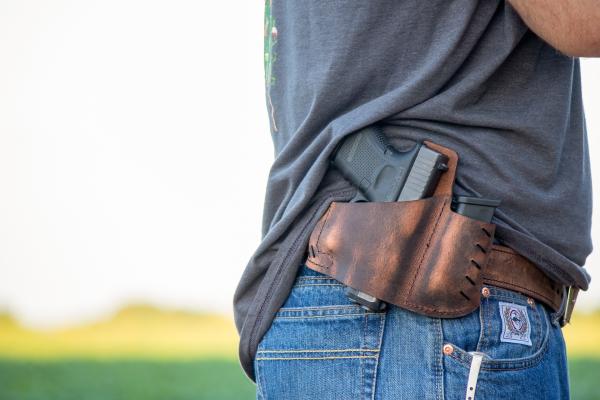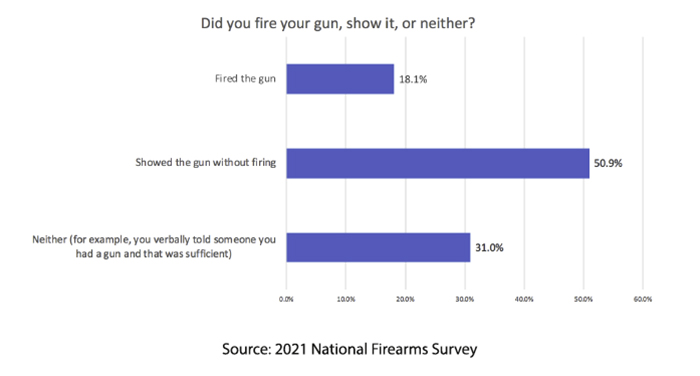The headline only captures a portion of the story; a deeper look reveals some interesting tidbits. The number and percentages are extrapolated from the National Firearms Survey in 2018, a national web-based survey of gun owners reflecting national demographics. Of the 6721 invited gun-owning participants, two-thirds completed the survey. The number of individuals carrying a loaded handgun
- Increased from 9 million in 2015 to 16 million in 2019
- 6 million carried a loaded handgun daily, up from 3 million
- Personal protection against people was by far the most significant reason to carry, 71.8%
- Individuals carrying were more often young, male, and from the South, owners of both handguns and long guns.
- There was no significant difference in carrying owners based on race, educational attainment, income, urbanicity, the presence of children in the household, or status as a veteran.
Permitless and shall-issue states differ in whether a permit to carry a concealed weapon are required, but in neither case does the state have discretion in whom to approve or deny; May issue states require permits and exercise discretion, although that Supreme Court decision reduces that discretion quite a bit.
It is clear that “may issue states” had a much smaller percentage of citizens legally carrying handguns. There were, as might be expected, scofflaws – individuals carrying in “May Issue” states without a permit, roughly 7.5%, a number quite a bit higher than the percentage in 2015 of 1.2% - so the cynical may conclude that for many individuals their constitutional “rights” override any state-mandated “responsibilities.”
The researchers end by citing the Supreme Court decision that loosened firearm-carrying regulations suggesting that the public health implications needed further research and study. Fair enough.
Updating the National Firearms Study
The latest study, involving 16,708 gun owners, was completed in July 2021. You can find the initial results here. Once again, about a third of Americans own guns, 58% male. Once again, self-defense is the primary reason for carrying a firearm. But this more recent study yields some additional information on self-defense. Roughly half of gun owners “indicate that there are some circumstances for which they carry a handgun for self-defense.” Evidently, about a third of these individuals live in “may issue” states having “wanted to carry a handgun for self-defense in a particular situation, but local rules prohibited them from doing so.”
Self-Defense
 The respondents report some discretion in when they carry, more often in dangerous circumstances rather than constantly.
The respondents report some discretion in when they carry, more often in dangerous circumstances rather than constantly.
But given that self-defense is the reason, by far and away, most given for carrying, what information can we find about that behavior?
According to the survey, 30% of gun owners have used their weapons in self-defense; gun owners have defended themselves 1.67 million times annually. I found that to be a rather startling statistic. Here are a few more findings to mull over.
- A majority of those gun owners cited more than one instance of self-defense
- 79% of these events occurred in the home or outside the home on their property; 9% in a public space, and 3% at work (both of those are troublesome)
- Handguns were the most commonly associated weapon at 66%
- 49% of the time, there was only one assailant; the rest of the time, the slight majority, there were two or more assailants.
Guns were fired nearly 20% of the time, which would work out to over 900 times a day. I find that number a bit too high.
As with many research concerns, there are problems with definitions, data collection, and bias. The information I presented on the latest National Firearms Survey comes from an author accused of biasing data to show more episodes of defensive gun use (DGU). The FBI and law enforcement generally do not track DGUs as a separate category. Many researchers instead use the National Crime Victimization Survey (NCVS), “a twice-yearly poll of crime victims conducted by the federal government.” The NCVS reporting on data through 2018 quoted a 2% use of DGU or about 191 times daily.
Clearly, we need more research on our use of guns if we are to develop laws governing their use based on our behavior rather than some arbitrary politicized belief that guns are good or bad. Equally clear is that gun use has an opportunistic quality; the more guns available, the more likely they will be around for self-defense and mayhem.
Sensitive Places
Having significantly lowered the bar in terms of restricting who may carry a firearm in public, the Supreme Court also incorporated language they used in a prior decision (District of Columbia v. Heller); that the possession of guns in sensitive places could be prohibited, the two examples given, government buildings and schools; subsequently extended to the area around the US Capitol, US post offices, and their respective parking lots, as well as legislative assemblies and polling places.
But the Court does not explain why one place would be considered sensitive and another not. Times Square is not considered a sensitive place, but would that be equally true for Times Square on New Year’s Eve? If you go back to look at when individuals carry firearms, it is most frequently the times when they are most fearful of danger. But as the scholar point out below, isn’t that the time when the place is most sensitive, and guns should be prohibited? As with many of our arguments, public safety issues exist on both sides of the debate.
Is public transportation a sensitive space? Does that apply to taxis, buses, trains, or the subways – we have had gun violence on all of them. Entertainment venues? We’ve had gun violence in movie theaters; should we wait to act on stadiums used for sporting events and concerts?
Source: Trend in Loaded Handgun Carrying Among Adult Handgun Owners in the United States, 2015–2019 American Journal of Public Health DOI: 10.2105/AJPH.2022.307094






